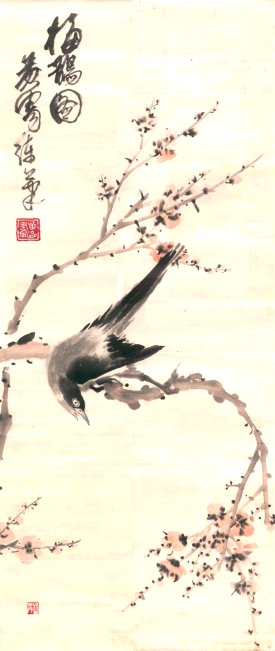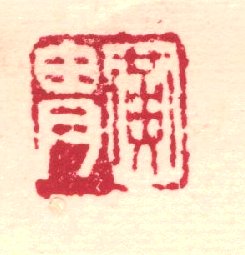



Bird and Mei Flower Painting by Famous Contemporary Painter Huang Zhou (1925-1997 )
當代名畫家黃冑 (1925一1997 ) 梅鵲圖
Huang Zhou (1925-1997)
Huang Zhou was born in a farmer's family in Hebei Province. He was interested in painting in his childhood. His family moved to Xi'an when he was eight. He learned from the Chinese painter Zhao Wangyun in 1940, went to Dunhuang to sketch in 1945, and then in 1949, aged 24, he joined the Chinese Liberation Army. He was a Director of the Chinese Painting Research Institute and the Director of the Chinese Yan-huang Art Gallery.
His artistic creativity reached a peak in the 1950s and 1960s. His painting Windstorm in Wastel and won the Golden Award in an International Youth Art Festival. Many other works, such as Singing Group, Spring Orchid and Soldiers on a Plateau, were also produced in this period. His second peak came in the 1970s, and his paintings of this period include Grassland Celebration, Feeding the Chicken, Wind and Snow Welcoming the Spring, and Missing Chairman Mao. Huang Zhou was also good at drawing animals, such as camels, pigs, chickens and ducks, but he mostly specialized in painting donkeys and dogs. Huang was a dedicated artist; besides creating paintings, he helped to build the Academy of Traditional Chinese Paintings, the Chinese Arts And Crafts Museum and established the Yanhuang Art Gallery by himself.
Huang Zhou was an excellent Chinese figure painter with a creative spirit. He received no formal artistic education, but mainly studied on his own, drawing countless sketches to improve his painting skills and finally forming his own artistic style. Some modern Chinese painters inherited traditional Chinese painting styles by paying too much attention to brush stroke techniques and ignoring accurate body shape, while some other painters learned doggedly from Western sketches and put aside traditional Chinese painting methods. Huang Zhou learned from both the Chinese painting traditions and the accurate portrayals in Western pictures. His paintings aimed at revealing the true objects and feelings in life. After long years of practicing sketches, he increased his understanding of live subjects, and could quickly grasp the most representative or typical moment to be included in his painting to capture the characteristics of his subjects. Huang Zhou's paintings vividly depict people's life situation, attracting viewers to be involved in his artistic work.
Huang Zhou liked to paint the life of the ethnic minorities in northwest China: the Uygurs, the Kazaks and the Tibetans. There are very few contemporary Chinese painters who can so vividly portray the life of the minorities. Huang usually drew lines to form the body shape of his figures. Unlike the stylized lines in traditional Chinese paintings, Huang's lines are fluid and vigorous, revealing a relaxed and free painting style. The lines of the face and hands are decisive and hard, while those of other parts of the body are more complicated. These repeated lines form his unique painting style, making his paintings appear to be rich and harmonious in content. His paintings increase the expressive functions of the lines. In applying color, Huang used single bright colors together with inks to form a strong visual effect, a technique which displays both traditional and modern Chinese painting ideas. His award-winning works were selected for exhibitions in many large-scale exhibitions both within and outside China.
Huang Zhou (1925-1997)
Huang Zhou e` nato nelle campagne della Cina settentrionale. Comincio` a dipingere quando aveva 11-12 anni. Da piccolo ebbe per maestro il celebre pittore Zhao Wangyun che eccelleva nel ritrarre personaggi e asini. Huang Zhou supero` il maestro. Nel rotolo “I cento asini”, creato nel 1979, figurano ben 97 asini, uno diverso dall’altro e tutti vivissimi nel portamento: ce ne sono che corrono, che saltano, che si grattano per il prurito, che succhiano il latte, in piedi, sdraiati o che si rotolano. Insomma 97 asini in 97 diversi atteggiamenti e pose. Nessuna ripetizione e nessuna impressione di sforzo stentato. Si puo` dire che Huang Zhou e` veramente un grande pittore di asini. Ma perche' ama ritrarli? Egli stesso ha spiegato il perche': in primo luogo, e` cresciuto nella Cina nord-occidentale, dove vedeva spesso asini e percio` li conosceva abbastanza. In secondo luogo, gli asini sono buoni aiutanti dei contadini nel loro lavoro e nella loro vita nelle campagne cinesi; essi sono abituati a sopportare la fatica e sono piuttosto industriosi, percio` meritano di essere rappresentanti; in terzo luogo, prendendo come esempio la riuscita esperienza degli antichi con la massima: “specializzarsi in un mestiere”, ossia “impadronirsi di un’espediente per poi diventare bravo sotto tutti gli aspetti”, penso` di partire dalla pittura di asini per poi appropriarsi delle tecniche del pennello e dell’inchiostro e formare cosi` il proprio stile artistico, sia ritraendo asini che altri soggetti. Per quanto riguarda gli asini, egli ha veramente raggiunto una perfetta tecnica e li puo` ritrarre senza la minima difficolta`. Inoltre egli ama dipingere anche altri animali, in specie il cammello. Sotto il suo pennello, i cammelli sono grandi e robusti e appaiono molto vigorosi; il quadro che nel 1957 conquisto` la medaglia d’oro al 6° Festival mondiale della gioventu` era esattamente un’opera che descriveva i cammelli in una tempesta di neve. Gli animali usciti dal suo pennello, che siano asini graziosi e abili, cavalli valenti e robusti, cammelli grossi e tarchiati o yak onesti e gentili, risaltano vivi come veri dal foglio di carta. Tuttavia i piu` riusciti e i piu` numerosi dipinti di Huang Zhou restano i personaggi umani.
Ogni volta che parla della propria attivita` creativa, Huang zhou pone sempre in rilievo che la vita e` la fonte della creazione, ed e` anche l’unica fonte. Entrato nel 1949 nell’esercito, Huang Zhou si impegno` nel lavoro di propaganda, disegnando caricature, manifesti, fumetti ed altri tipi di dipinti. Nonostante non abbia ricevuto una formazione specialistica, la lunga pratica artistica gli ha permesso di impadronisrsi delle tecniche del pennello e dell’inchiostro della pittura tradizionale cinese. E’ vissuto per molto tempo nella Cina nord-occidentale e nella regione del Xinjiang Uygur, lavorando tra le popolazioni locali di varie etnie. Dedicava molto tempo a fare schizzi, affinare le tecniche e accumulare materiali. Secondo alcune stime, i suoi dipinti assommano a oltre 10.000.
Una volta Huang Zhou ha detto: “Trovo sempre difficile tratteggiare una pittura nello stile tradizionale cinese, perche` la pittura tradizionale cinese e` diversa da quella occidentale, la pittura a olio ha le sue, cioe` l’idealizzazione concettuale. Alcuni pittori dipingono bambu`, pini o rocce, pero` nei dipinti esiste questa idealizzazione concettuale che riflette l’ambizione e il carattere del pittore, esercitando su chi li guarda influenza e ispirazione”. Egli ha anche aggiunto: “Per impegnarsi nella pittura tradizionale cinese bisogna avere una educazione letterale che e` unione di poesia, calligrafia e pittura. Piu` profonda e` la preparazione letteraria, piu` sara` profonda l’allusione poetica e l’idealizzazione concettuale dei dipinti. A parte l’ispirarsi alla vita, bisogna anche possiedere la tecnica e l’unico metodo di impossessarsi della tecnica del pennello e dell’inchiostro della pittura tradizionale cinese e` di fare esercizi e di tratteggiare tanti schizzi”. Tutti coloro che conoscono Huang Zhou sanno che il pollice, il medio e l’indice della sua mano destra sono deturpati da spessi calli: ecco il segno di decine di anni del suo lavoro e affinamento.
黃胄(1925 - 1997)
原名梁黃胄,又名淦堂,字映齊。男,漢族,河北媼縣人,1925年3月生。自幼喜好繪畫,1940年師從趙望雲,1945年隨趙望雲到敦煌寫生。1948年入伍,隨軍到甘肅、青海、新疆等地,任西北軍區戰士讀物出版社美術記者和編輯。1950年兼任西北師範學院藝術系講師,後在部隊從事專業創作。1955年調北京為中國人民解放軍總政治部創作室任創作員。1959年調中國人民革命軍事博物館任創作員。1975年調至輕工業部藝術美術公司任顧問。曾任中國畫研究院副院長、中國美術家協會常務理事、全國政協委員。一級美術師。曾集資和捐款籌建炎黃藝術館。黃氏於1997年春去世。
擅人物、動物畫,長于運用速寫表現人物,善于抓住人物的特征,闊筆縱橫,線條流暢而有力,特別注重刻劃人物的面部表情和細微動作,整體效果生動,風格奔放而雋永,生活氣息濃鬱。善畫毛驢、駱駝、雞、貓、狗等,造型準確,意態生動,簡括傳神。作品多次入選國內外大型美術作品展覽並獲獎及在多種專業報刊上發表,影響較大。主要作品有《蘋果花開的時候》、 《打馬球》、 《帳篷小學》、 《祖國的眼睛》、 《金色的道路》、《洪荒風雪》、《載歌行》、 《奔騰急》、 《豐收圖》、 《巡邏圖》、 《趕集》、《親人》、 《談心》、 《歡騰的草原》、 《百驢圖》等。 其中《蘋果花開的時候》獲1952年全國美術作品展覽一等獎、《打馬球》獲全國青年美術作品展覽一等獎,《爹去打老蔣》參加第一屆全國美展,獲一等獎、1956年創作的《洪荒風雪》獲第六屆世界青年聯歡節國際造型和實用藝術展覽會金質獎章,為中國美術館收藏。《趕集》於1959年獲世界青年聯歡節銅質獎章。出版《黃胄作品選集》、 《動物寫生》、《黃胄速寫集》、《黃胄》(畫冊)、《黃胄新作選》、《喀什噶爾速寫集》、《載歌行一黃胄天山南北作品集》、《百驢圖》等。現為中國美術家協會常務理事,中國畫研究院副院長。
作品價格
黃胄作品主要在香港和北京出售。香港藝術市場從1987年開始定期拍賣黃胄作品,最早拍賣的《扇舞圖》達21000港元。1987年11月拍賣的《駱駝與犬》價格升到26000,1990年又漲至6萬多港元。北京市場出售最多的是榮寶齋,價格在每幅1∼3萬元人民幣。其他各大飯店附設的畫廊偶爾也有出售,價格大同小異。1992年5月大陸首次書畫拍賣會在廣州廣交會大廳舉行,黃胄送交的《群驢圖》經幾番競爭,以53萬元人民幣拍出,高出底價23萬元。
現在國內無論是大拍還是小拍,一般都有黃胄的作品,但拍賣會中也時有假畫出現。
Click Here to See Other Contemporary Artists Paintings
Click Here to See Other Paintings
Click Here to Go Back to Homepage